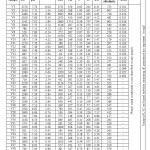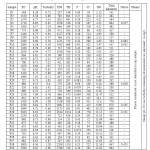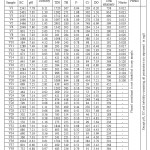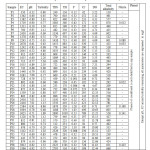Study of Some Physical & Chemical Characteristic Properties of Ground Water in the Villages of Veeraghattam and Palakonda Mandals in Srikakulam District, A.P, India.
Nadikatla Santhosh Kumar1 , Mushini Venkata Subba Rao1 * and M. P. S. Murali Krishna2
1
Department of Chemistry,
Rajam,
G M R Institute of Technology,
Srikakulam,
532127
Andhra Pradesh
India
2
Chemistry Department,
Andhra Polytechnic,
Kakinada,
Andhra Pradesh
India
DOI: http://dx.doi.org/10.12944/CWE.10.2.26
Human beings require potable water for drinking to keep them healthy. Clean, safe and adequate fresh water is vital to the survival of all living organisms. Drinking water affects the health of human beings due to the presence of various dissolved chemical constituents. Problems arising out of chemical constituents in drinking water are different from the problems of microbial contamination. Therefore, consumers should have at least minimum knowledge on quality of drinking water. People across the world depend on ground water for drinking. Ground water is a major source, so based on the importance of the matter; a research topic is taken up on the assessment of quality of groundwater in the selected areas of villages in Veeraghattam and Palakonda Mandals of Srikakulam District, Andhra Pradesh. This preliminary study assessed the quality of physical and chemical characteristic properties of underground water in the selected locations of 40 villages in Veeraghattam and 39 villages in Palakonda Mandals of Srikakulam District. Some physico chemical characteristic parameters are estimated in the samples and the results obtained are compared with the available standard values such as WHO and BIS.
Copy the following to cite this article:
Kumar N. S, Rao M. V. S, Krishna M. P. S. M. Study of Some Physical & Chemical Characteristic Properties of Ground Water in the Villages of Veeraghattam and Palakonda Mandals in Srikakulam District, A.P, India. Curr World Environ 2015;10(2) DOI:http://dx.doi.org/10.12944/CWE.10.2.26
Copy the following to cite this URL:
Nadikatla Santhosh Kumar N. S, Rao M. V. S, Krishna M. P. S. M. Study of Some Physical & Chemical Characteristic Properties of Ground Water in the Villages of Veeraghattam and Palakonda Mandals in Srikakulam District, A.P, India. Curr World Environ 2015;10(2). Available from: http://www.cwejournal.org?p=799/
Download article (pdf) Citation Manager Publish History
Select type of program for download
| Endnote EndNote format (Mac & Win) | |
| Reference Manager Ris format (Win only) | |
| Procite Ris format (Win only) | |
| Medlars Format | |
| RefWorks Format RefWorks format (Mac & Win) | |
| BibTex Format BibTex format (Mac & Win) |
Article Publishing History
| Received: | 2015-04-12 |
|---|---|
| Accepted: | 2015-06-29 |
Introduction
Water is renewable natural resource of earth and sustains the needs of all living creatures in the world1 and health depends on the availability of drinking water. It is considered a basic human right and a part of effective policy2 for protection of health.
Groundwater is one of the major sources of drinking water in both urban and rural India and the quality comprises the physical, chemical, and biological properties of ground water. Quantity and Quality Management3 of groundwater presents the best of current thinking on managing groundwater resources. It focuses on the interrelationship between quantity and quality. Potable ground water is an essential resource, yet it is exploited and contaminated3 in developed and developing countries.
Water quality has significant role in human health and both natural and anthropogenic effects4 govern the quality of ground water within a region. Availability of potable drinking water is essential to human health5 all over the world. If groundwater contains high amount of various ions and salts, using it for leads to various water borne diseases.6
Groundwater is considered as one of major part of the purest forms of water available in Nature to serve the needs of rural and urban people. Major part of the Indian populace depends upon freshwater supplies from open wells, ponds, bore wells, natural springs etc. In addition to this, also groundwater is continuously used for irrigation in rural India. Due to increased human population, growth of industrial activities, dumping of industrial waste, improper disposal of garbage, use of fertilizers in agriculture and manmade activities, quality of water is polluted in most areas. Rapid growth in population and the quick pace of industrialization required more potable water and this need affected the quality of water.7 Enormous use of fertilizers and poor conditions in agricultural development led to the damage of human health.8 Taking all these factors are consideration, the researchers conclude that people should have at least minimum knowledge on quality of drinking water.
The groundwater quality is assessed to find out the presence of physico-chemical substances and these substances widely change9 due to the conditions like pollutions of various types, variations in monsoon and overutilization of potable groundwater etc. Therefore, it is mandatory to monitor the quality of potable ground water to alleviate the problem of pollution in water and pollution causing agents are to be controlled. Human welfare has directly related to the quality of ground water. Therefore, monitoring the water quality is one of the essential10 issues of drinking water management. This research work attempts to evaluate the some physical and chemical parameters of potable groundwater in the selected locations of villages in Veeraghattam and Palakonda Mandals of Srikakulam District, Andhra Pradesh.
Experimental
Water sampling
The water samples are collected as per standard procedure11 in the month of February 2013 and March 2014 from the selected sites in the villages of Veeraghattam and Palakonda Mandals. They are analyzed immediately for various parameters or preserved safely by taking care with suitable standard precautionary methods to avoid deterioration/alteration. All the water samples are collected in 2 Liters plastic bottles that were washed and double rinsed with distilled water before sampling. The list of sample collection areas/villages in Veeraghattam and Palakonada are given in the Table 1.
Table1: List of sample collection sites in Veeraghattam and Palakonda Mandal
|
Sample |
Veeraghattam mandal |
Sample |
Palakonda mandal |
||
|
Location/Villages |
Source |
Location/Villages |
Source |
||
|
V1 |
Veeraghattam |
Open well |
P1 |
Sirikonda |
Bore well |
|
V2 |
Veeraghattam |
Bore well |
P2 |
Velaga vada |
Open well |
|
V3 |
Veeraghattam |
Bore well |
P3 |
Velaga vada |
Tap water |
|
V4 |
Veeraghattam |
Open well |
P4 |
P.R.Rajupeta |
Bore well |
|
V5 |
Veeraghattam |
Bore well |
P5 |
Singannavalasa |
Bore well |
|
V6 |
Veeraghattam |
Open well |
P6 |
Parasurama puram |
Bore well |
|
V7 |
Talavaram |
Bore well |
P7 |
N.K.Rajapuram |
Open well |
|
V8 |
Panasa Nandivada |
Bore well |
P8 |
Kondapuram |
Bore well |
|
V9 |
Neelanagaram |
Bore well |
P9 |
Vadama |
Bore well |
|
V10 |
Tettangi |
Bore well |
P10 |
Ampili |
Open well |
|
V11 |
Bitiwada |
Bore well |
P11 |
Annavaram |
Bore well |
|
V12 |
Adaru |
Open well |
P12 |
Goidapeta |
Open well |
|
V13 |
Bodlapadu |
Bore well |
P13 |
Chinna Mangalapuram |
Bore well |
|
V14 |
Regulapadu |
Open well |
P14 |
PeddaMangalapuram |
Bore well |
|
V15 |
Kella |
Open well |
P15 |
Gopalapuram |
Bore well |
|
V16 |
Nadimikella |
Bore well |
P16 |
Navagam |
Open well |
|
V17 |
Kambara |
Bore well |
P17 |
Avalangi |
Bore well |
|
V18 |
Kambaravalasa |
Bore well |
P18 |
G.Venkatapuram |
Open well |
|
V19 |
Vikrampuram |
Bore well |
P19 |
Potli |
Open well |
|
V20 |
Nadukuru |
Bore well |
P20 |
R.B.R.Peta |
Open well |
|
V21 |
Santha Narsipuram |
Bore well |
P21 |
Dolamada |
Open well |
|
V22 |
Mahadevavalasa |
Bore well |
P22 |
Jamparakota |
Bore well |
|
V23 |
Dasamanthuram |
Bore well |
P23 |
Baddumasingi |
Bore well |
|
V24 |
Chalivendri |
Open well |
P24 |
Singupuram |
Bore well |
|
V25 |
Buruga |
Bore well |
P25 |
Malle veedu |
Open well |
|
V26 |
S.Gopalapuram |
Open well |
P26 |
Padmapuram |
Bore well |
|
V27 |
Kottugummada |
Bore well |
P27 |
Basuru |
Bore well |
|
V28 |
Kottugummada |
Open well |
P28 |
V.P.Rajupeta |
Bore well |
|
V29 |
Gadagamma |
River water |
P29 |
Lovidi Laxmipuram |
Bore well |
|
V30 |
Tudi |
Bore well |
P30 |
Kotipalli |
Open well |
|
V31 |
Tudi |
Open well |
P31 |
Gudivada |
Open well |
|
V32 |
Chdimi |
Bore well |
P32 |
Garugubilli |
Bore well |
|
V33 |
Palametta |
Bore well |
P33 |
Lumburu |
Bore well |
|
V34 |
Kummidi |
Open well |
P34 |
Tampatapalli |
Open well |
|
V35 |
Gangampeta |
Bore well |
P35 |
Tumarada |
Open well |
|
V36 |
Rajapuram |
Open well |
P36 |
Attali |
Bore well |
|
V37 |
Kattula Kaviti |
Open well |
P37 |
Panukuvalasa |
Bore well |
|
V38 |
Hussenpuram |
Open well |
P38 |
Voni |
Bore well |
|
V39 |
Venkampeta |
Open well |
P39 |
Chintada |
Bore well |
|
V40 |
Achipuvalasa |
Bore well |
|||
Instruments used
The following instruments like UV-Visible Double beam Spectrophotometer (Model AU – 2701, Systronics), Digital pH meter (Model 335, Systronics), Nefleometer (Model 132, Systronics), Digital Conductometer(Model 306, Systronics), Micro processor based bunch PH / Ion meter, Cyber scan 2100, Eutech instruments (USA) with fluoride sensitive electrode are used to analyze for various constituents present in groundwater samples.
Chemicals used
All the Chemicals used are of Analytical Reagent Grade (Merck, BDH and Qualigens) and the solutions are prepared by using triply distilled water. The following solutions are used in this research work like Potassium hydrogen phthalate, Potassium hydrogen phosphate, Potassium dihydrogen phosphate, Calcium Carbonate, EDTA, Na2CO3, HCl, NaCl, AgNO3, Sodium oxalate, Potassium permanganate, Ferrous Ammonium Sulphate, K2Cr2O7, concentrated nitric acid, Hypo, 10 % BaCl2, 10% KI , 1000 ppm of fluoride and Nitrite solution, stock phenol solution, 4-aminoantipyrine, Potassium ferricyanide, chloroform, Ammonium chloride-ammonium hydroxide buffer solution, TISAB Buffer, AgNO3 – Nitric acid reagent, Vanadate – molybdate reagent, 0.5% Sulphanalamide reagent and indicators of phenolphthalein, methyl orange, EBT, Muroxide, K2CrO4 and 1% Starch.
Estimation of various constituents in water
Estimation of various constituents present in the groundwater like pH, Electrical Conductivity(EC), Turbidity, Total Dissolved Solids(TDS), Alkalinity, Total Hardness(TH), Fluoride(F-), Chloride(Cl-), Nitrite(NO2-), Dissolved Oxygen(DO) and Phenol are estimated by respective methods12.
Results and Discussion
Forty water samples are collected from Veeraghattam Mandal and thirty-nine water samples in the Palakonda mandal of Srikakulam District in the month of February 2013 and March 2014. The results related to analyzed physico chemical parameters in the sample areas are presented in the Tables 2, 3, 4 & 5 and these values are compared to established standard values like WHO13 and BIS.14
 |
Table 2: Various constituents present in the water samples in Veeraghattam mandal (February 2013) Click here to View table |
 |
Table 3: Various constituents present in the water samples in Palakonda mandal (February 2013) Click here to View table |
 |
|
 |
Table 5: Various constituents present in the water samples in Palakonda mandal (March 2014) Click here to View table |
pH
It is one of the important factors of ground water. pH is under the desirable limit all the samples of study area as per WHO and BIS.
Electrical conductivity
Ground water can be assessed with the measurement of conductivities and this indicates level of the concentration of the TDS and major constituents. In the samples of (V1 to V6, V20 and V32) Veeraghattam Mandal and the samples of (P7, P9, P10, P12, P26, P27, P29, P38 and P39) in Palakonda mandal, these readings are more than the desirable limit.13,14
Total Dissolved Solids (TDS)
They are the concentration of dissolved chemical constituents in water and it presents the clear idea of salinity. In the sample number V5 in the area of Veeraghattam mandal and samples of P29, P34, P38 and P39 of Palakonda mandal, the TDS content is more than the permissible limit. Based on obtained TDS values except sample V5 & samples of P29, P34, P38 and P39 in Veeraghattam and Palakonda areas are suitable to drinking as per the limits of WHO/BIS.
Total Hardness (TH)
It is considered a main characteristic property of potable drinking water. Calcium and Magnesium are the most common sources of water hardness. Except few samples V3, V5, V11 and V32 in Veeragahattam mandal & samples of P2, P7, P9, P10, P29, P38 in Palakonda mandal, remaining all samples in the study area, the hardness content is within the desirable limit as per BIS.
Chloride (Cl-)
It originates from Sodium Chloride, which is present in water from soil and rock. This shows the quality of potable ground water and if it is in excess concentration, it mighat have been mixed with sewage or seawater. In this study area, all the samples are having Chloride content within a permissible limit as per BIS.
Fluoride (F-)
Except the samples V2, V9, V13, V17, V20 and V39 in Veeraghattam mandal, all the remaining samples in the research area, the content of fluride concentration is within the desirable limit as per standards.
Total Alkalinity
Except a few samples in Veeraghattam mandal( samples V1, V2, V3, V5, V20 and V39) and Palakonda mandal( samples P4, P26, P27, P38 and P39), all the remaining samples in both areas are within the desirable limit. The phenol constituent is not identified in the samples and the nitrite is under desirable limit in the entire research area.
Based on the results obtained, evaluation of quality of underground water for potability in the selected areas of Veeraghattam and Palakonda mandals, the underground water quality is good as per the limits WHO and BIS. In some sites, some of the constituents are not within the desirable lim. In this aspect, further studies are carried out to identify the causes and solve the problem.
References
- Bathusha M. I. and Saseetharan M K., Statistical study on Physico – Chemical characteristics of ground water of Coimbatore south zone, Indian j. environ. Prot., 26(6), 508-515 (2006)
- Guidelines for Drinking – Water quality, World Health Organization (WHO), Third edition, Geneva (2008)
- Mustafa M. A. and Stewart W. T., Groundwater Quantity and Quality Management, American Society of Civil engineers. (2011).
- Mahajan G.D., Hydro chemical characteristics and quality assessment of groundwater in parts of kannad, district Aurangabad (ms) India, International journal of Recent Trends in Science And Technology., 3(3), 71-76 (2012).
- ulia M. B. Robert S. and Ryan P., Cisterns and safe drinking water in Canada, Canadian Water Resources Journal., 38(2), 121-134 (2013).
- Arvnabh M. Vasishta D. B. Nirav S. Pinal S. Kirit P. and Chaitanya P., Comparative Study of Physico-Chemical and Microbial Parameters on Lotic And Ground- Waters In Selected Outlying Areas Of Central Gujarat, J.Chem.Pharm.Res., 2(4), 174-177 (2010).
- Nareshkumar. SukhvinderSingh P. kritika R. Ashish P. and Amitkumar., To study the Physico - Chemical Properties and Bacteriological examination of step well water from Majhwar region in Distt. Mandi of Himachal Pradesh, India, International Journal of Current Research., 5, 4118-4123 (2013).
- Abraham B. G. Nata T. and Elias J., Application of water quality index to assess suitability of groundwater quality for drinking purposes in Hantebet watershed, Tigray, Northern Ethiopia, ISABB Journal of Food and Agriculture Science., 1(1), 22-30 (2011).
- Srinivas Rao G. and Nageswararao G., Assessment of Groundwater quality using Water Quality Index., ARCH. ENVIRON. SCI., 7, 1-5 (2013).
- Shama S. IffatNaz. Mohammad I.A. and Safia A., Monitoring of Physico – Chemical and Microbiological Analysis of Under Ground Water Samples of District KallarSyedan, Rawalpindi, Pakistan, Research Journal of Chemical sciences., 1, 24-30 (2011).
- Reza R. and Singh G., Physico – Chemical analysis of groundwater in Angul – Talcher Region of Orissa, India, Journal of American Science., 5, 53-58 (2009).
- Subba Rao M. V. Dhilleswararao V. and Andrews B. S. A., Assessment of Quality of Drinking Water at Srikurmam in Srikakulam District, Andhra Pradesh, India. Int Res J Environment Sci., 1(2), 13-20 (2012).
- World Health Organization, “Guidelines for Drinking - Water Quality,” 3rd Edition, World Health Organization (WHO), Geneva, Switzerland. WHO (2004).
- Specifications for Drinking Water. Bureau of Indian Standards. New Delhi, India, (1991).







